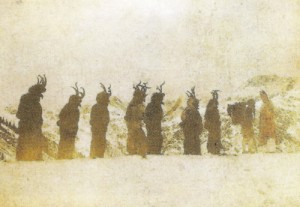Time is a system of measurement, which is to say, a ruler, and authority. There is a reason why, during many insurrections, clocks have been smashed and calendars burned. There was a semi-conscious recognition on the part of the insurgents that these devices represented the authority against which they rebelled as much as did the kings or presidents, the cops or soldiers. But it never took long for new clocks and calendars to be created, because inside the heads of the insurgents the concept of time still ruled.
Time is a social construction which is used to measure motion through space in order to control it and bind it to a social context. Whether it be the motions of the sun, moon, stars and planets across the skies, the motions of individuals over the terrains they wander, or the motions of events across the artifices know as days, weeks, months and years, time is the means by which these motions are bound to social utility. The destruction of time is essential to the liberation of individuals from the social context, to the liberation of individuals as conscious, autonomous creators of their own lives.
The revolt against time is nothing if it is not a revolt against the domination of time in one’s daily life. It calls for a transformation of the ways in which one moves through the spaces one encounters. Time dominates our motion through space by means of “necessary” destinations, schedules and appointments. As long as the social context which produced time as a means of social control continues to exist, it is doubtful that any of us will be able to completely eradicate destinations, schedules or appointments from our lives. But on examination of how these modes of interaction affect the ways one moves through space could help one create a more conscious motion. The most notable effect of having to get somewhere (destination), especially when one has to be there by a certain time (schedule/appointment), is a lack of awareness of the terrain over which one is moving. Such motion tends to be a sort of sleep-walking from which the individual creates nothing, since the destination and the schedule pre-exist the journey and define it. One is only conscious of her surroundings and how they are affecting her to the minimal extent necessary to get where she is going. I don’t deny that many of the environments through which one may move, especially in an urban setting, can be disturbingly ugly, making such unconsciousness aesthetically appealing, but this lack of consciousness causes one to miss many chances for subversion and play that might otherwise be created.
Subverting one’s motion through space, making it one’s own, freed from the bondage to time, is a matter of creating this motion as nomadic motion rather than self-transportation. Nomadic motion makes a playful (though often serious) exploration of the terrain over which one is passing the essential aspect of the journey. The wanderer interacts with the places through which she passes, consciously changing and being changed by them. Destination, even when it exists, is of little importance, since it too will be a place though which one passes. As this form of motion through space becomes one’s usual way, it may enhance one’s wits, allowing one to become less and less dependent upon destinations, appointments, schedules and the other fetters that enforce the rule of time over our motions. Part of this enhancement of the nomad’s wits within the present time dominated context is learning to create ways to play around time, subverting it and using it against itself to enhance one’s free wandering.
A radically different way of experiencing living occurs when we are consciously creating time for ourselves. Due to the limits of a language developed within this time-dominated social context, this way of experiencing life is often spoken of in temporal terms as well, but as a subjective “time”, as in: “The time when I was climbing Mount Hood…” But I’d rather not refer to this as subjective “time” since it has no shared purpose with social time. I prefer to call it “nomadic experience”. Within nomadic experience, the peaks, the valleys and the plateaus are not created in steady, measurable cycles. They are passionate interactions of the sort which may make one moment an eternity and the next several weeks a mere eye-blink. On this passionate journey, the sun still rises and sets, the moon still waxes and wanes, plants still flower and bear fruit and wither, but not as measurable cycles. Instead, one experiences these events in terms of one’s passionate and creative interactions with them. Without any destination to define one’s motion through space, linear time becomes meaningless as well. Nomadic experience is outside of time, not in a mystical sense, but in the recognition that time is the mystification of motion through space and, like all mystifications, usurps our ability to create ourselves.
A conscious, playful, exploratory creation of our own motions through space, of our own interactions with the places we pass through, is the necessary practice of the revolt against time – nothing less than creating events and their language. Until we begin to transform ourselves into nomadic creators of this sort in the way we live our lives, every smashed clock and every burned calendar will simply be replaced, because time will continue to dominate the way we live.
please send corrections if you notice type-o’s or formatting errors: quiver@hush.com
